Learn how to care for and grow hydrangeas for blooms that last all summer long!
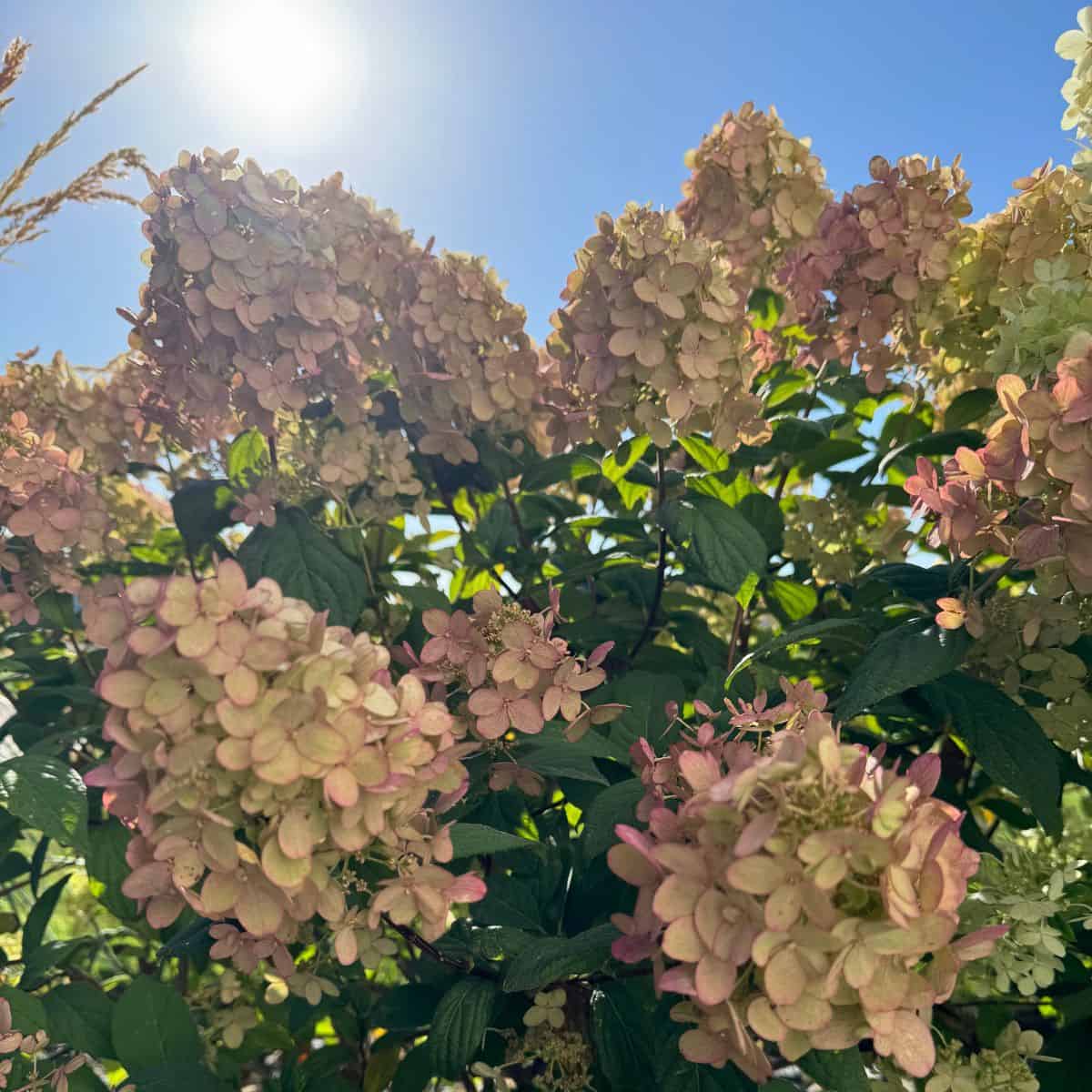
If you’re excited about adding those beautiful hydrangeas to your yard, I’ve got you covered with tips and tricks to care for and grow hydrangeas successfully. This will help make your hydrangea-growing a breeze!
Where to grow Hydrangeas
One of the most important part of growing big beautiful hydrangea flowers is planting them in the right spot. Planting hydrangeas in the wrong spot will end with brown dried out blooms, and smaller plants where growth has been retarded by too much sun or heat.
When you’re considering where to place hydrangea plants in your yard or garden, remember they do better with shade… I live in Fruitland Idaho (USDA hardy zone 6b) and plant my hydrangeas on the east side of my home for morning sun, and after noon shade!
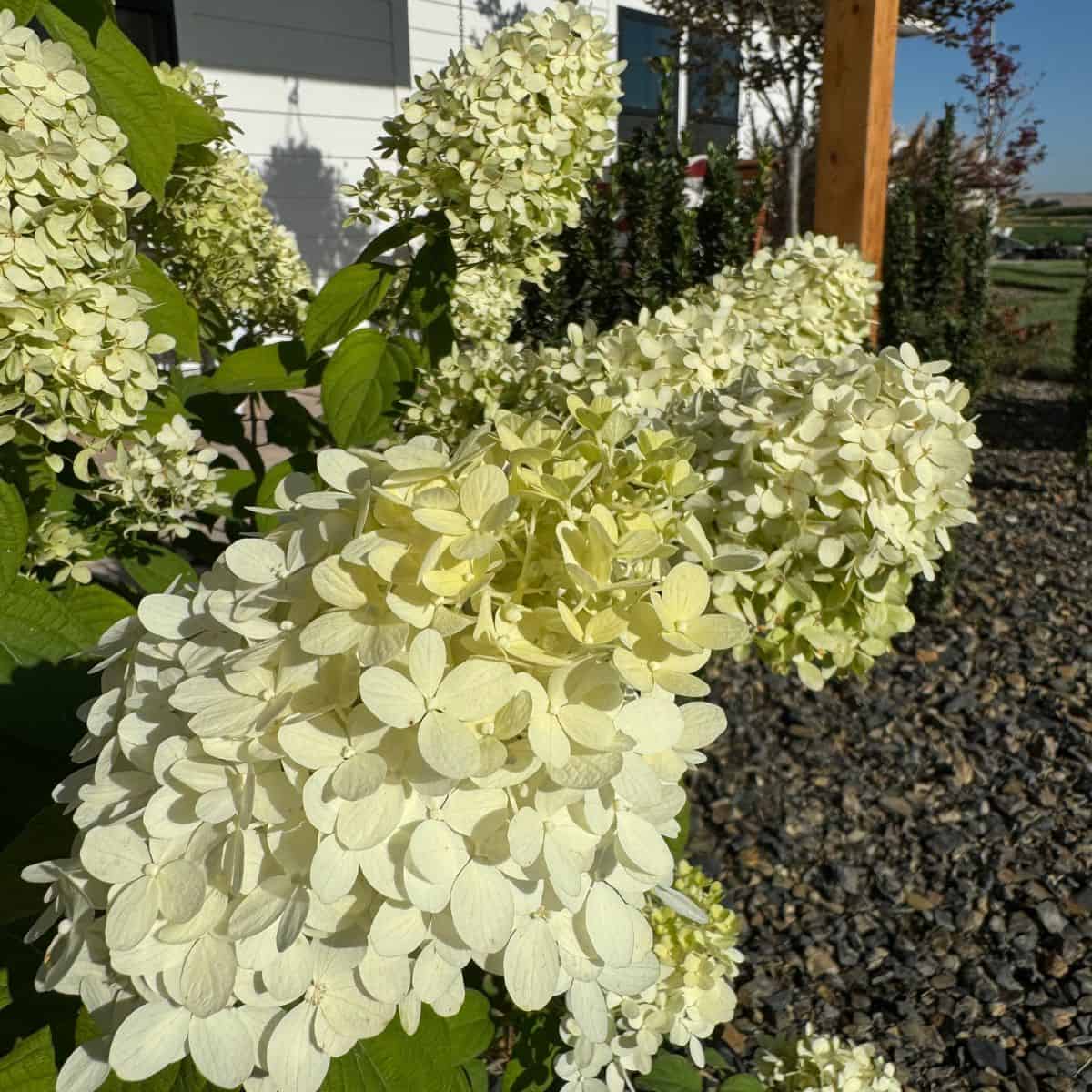
(I did try planting a variety that took more sun on the south side of my house, and their blooms were small and burnt up. Those plants also never grew more than 2 feet tall…. The the exact same variety thrives on the east side of my house.)
Most types of hydrangeas prefer morning sun with afternoon shade, especially in warmer climates! These protected areas prevent hydrangea blooms from getting scorched by the heat and the sun.
Hydrangeas can handle a bit more sun in COLD climates.
Bigleaf hydrangeas thrive in shade, while panicle hydrangeas and smooth hydrangeas “can” tolerate full sun, but they do much better with afternoon shade. Oakleaf hydrangeas appreciate afternoon shade in warmer climates.

Hydrangea Soil Prep
When it comes to growing hydrangeas soil preparation plays an important role.
Hydrangeas do best in LOAM soil. Loam is well draining soil with plenty of organic matter. It has a balanced texture made of an even mixture of sand, silt and clay. Plus loam soil has good water retention and great drainage… Providing the best environment for hydrangea plants to thrive!
Good drainage is key, it prevents root rot and fungal diseases. To improve drainage, amend soil with organic material like peat moss. This will aid in water retention and provide nutrients for healthy growth.
Adjusting Soil pH
Did you know that the pH of your soil can influence the color of your hydrangea flowers? For blue flowers, aim for a more acidic soil by adding materials like aluminum sulfate.
If you’re dreaming of pink blooms, add lime to make the soil slightly more alkaline.
Testing your soil’s pH allows you to make adjustments for your desired flower color.
When to Plant Hydrangeas
Early spring is the prime time prep soil and plant hydrangeas… Just as your hydrangea plants are waking up from their winter hibernation.
Plant hydrangeas in late spring after the last frost in cooler climates. In warmer climates plant hydrangeas in the fall!
Different Hydrangea Types
There are several types of hydrangeas, each with its own unique characteristics.
- Bigleaf hydrangeas (Hydrangea macrophylla) are famous for their large, showy flowers and come in varieties with pink, blue, or white flowers depending on the soil’s pH level.
- Oakleaf hydrangeas (Hydrangea quercifolia) have beautiful foliage and they’re perfect for colder climates!
- Panicle hydrangeas (Hydrangea paniculata) thrive in various conditions and are known for their cone-shaped flower heads that bloom in late summer.
- Smooth hydrangeas (Hydrangea arborescens) are hardy and produce lovely white flower clusters.
Types of Hydrangeas & Bloom Times
If you’re a fan of captivating blooms that steal the show in your garden, hydrangeas are probably on your radar!
These beauties come in various types, each with its own unique charm and bloom time. Let’s take stroll through some of the most popular hydrangea varieties and their blooms times.
Before purchasing hydrangeas, consider their mature size. If you have limited space, opt for compact varieties or climbing hydrangeas that won’t overwhelm your garden.
For shrub borders, bigleaf and panicle hydrangeas work wonders. If you’re a fan of showy flowers, lacecap and French hydrangeas are excellent choices;)

1. Bigleaf Hydrangeas (Hydrangea macrophylla)
Bigleaf hydrangeas are the classic garden darlings known for their large, colorful blooms. These lovelies are further divided into two main categories: mophead and lacecap.
Mophead hydrangeas produce big, round clusters of flowers that resemble pom-poms. Their bloom time usually spans from late spring to early summer.
Lacecap hydrangeas, on the other hand, showcase a delicate, flat arrangement of tiny blooms surrounded by larger ones. Their show starts around the same time as mophead hydrangeas.
2. Panicle Hydrangeas (Hydrangea paniculata)
Panicle hydrangeas bring a touch of elegance to the garden with their cone-shaped flower heads. These hardy hydrangeas steal the late summer spotlight, gracing us with their beauty from mid-summer to early fall.
As the name suggests, the panicle hydrangea’s blooms form in elongated panicles, starting off creamy white and gradually transitioning to shades of pink or even deep red as the season progresses.
3. Oakleaf Hydrangeas (Hydrangea quercifolia)
Oakleaf hydrangeas are all about textured foliage and subtle charm. These hydrangeas start showing off their unique cone-shaped flower heads in early summer. The blooms are often white, turning shades of pink or rusty red as they age.
Oakleaf hydrangeas are also known for their stunning fall foliage, making them a delightful addition to your autumn landscape.
4. Smooth Hydrangeas (Hydrangea arborescens)
Smooth hydrangeas bring an air of understated elegance to gardens. These beauties only bloom from late spring to early summer, offering clusters of white or light pink flowers. One of the most well-known smooth hydrangea varieties is ‘Annabelle’, famous for its large, round flower heads.
Smooth hydrangeas are fantastic choices for colder climates, as they can handle cold winters like pros.

5. PeeGee Hydrangeas (Hydrangea paniculata ‘Grandiflora’)
The PeeGee hydrangea, often referred to as the “tree hydrangea,” is a type of panicle hydrangea that can be trained into a small tree-like shape.
These hydrangeas bloom from mid-summer to early fall, offering a spectacular display of cone-shaped flower heads that gradually transition from white to pink.
Their versatility and ability to adapt to pruning make them popular choices for landscape design!
6. Climbing Hydrangeas (Hydrangea anomala petiolaris)
Climbing hydrangeas add a touch of enchantment as they gracefully cling to walls, fences, and arbors. Their white lacecap flowers start to make their appearance in early summer.
Climbing hydrangeas hydrangeas take a few years to establish themselves before putting on their full blooming spectacle. However, the wait is well worth it for the charming effect they create!
7. Mountain Hydrangeas (Hydrangea serrata)
Mountain hydrangeas, closely related to bigleaf hydrangeas, bring their unique flair to the garden. They typically bloom in late spring to early summer, offering delicate lacecap or mophead blooms in various shades of blue, pink, or purple.
Their compact size and captivating blossoms make them an excellent choice for smaller gardens or container plantings.
Planting Hydrangeas
Early spring or late fall is the best time to plant new hydrangeas. Choose a spot with afternoon shade, well-drained soil and good drainage to avoid issues like root rot.
Dig a hole that’s slightly larger than the root ball and incorporate organic material like peat moss into the soil for added nutrients.
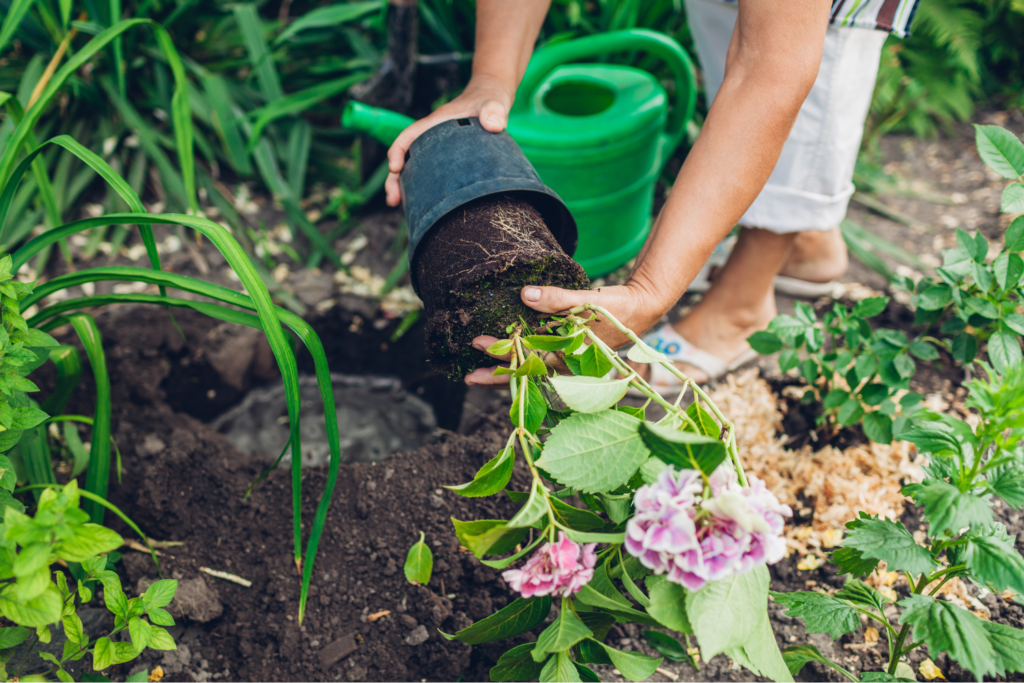
Carefully remove your hydrangea from the pot you bought it in by pulling the pot up… They plant facing down. Remove the pot carefully so you disturb the roots the least possible.
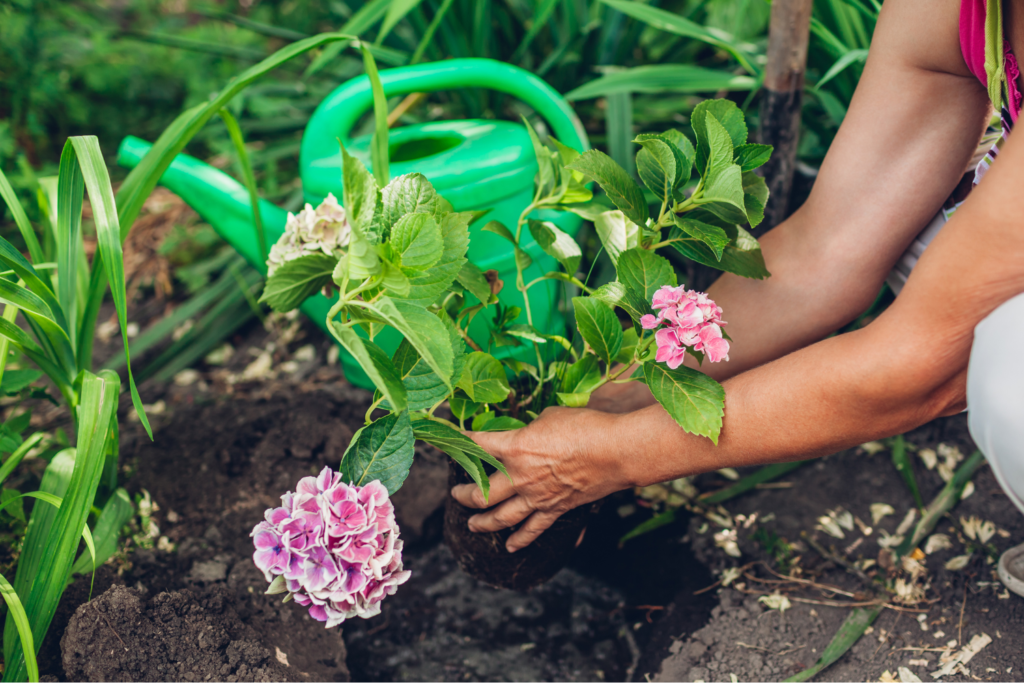
Place the roots and soil of the hydrangea plant in to your hole with the top of the plants soil even with your garden bed.
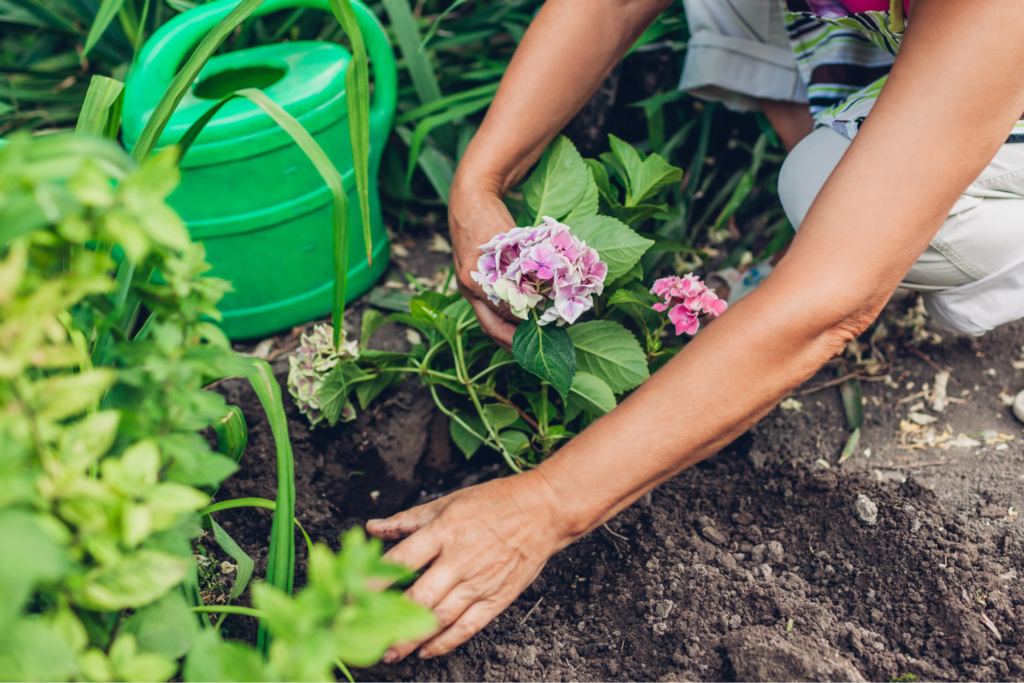
Fill in around the base of your plant with top soil and push down to compact it around your hydrangea plant.
How to Water Hydrangeas
Hydrangeas love a drink, especially during the growing season.
Give them about an inch of water every week to quench their thirst. But here’s the catch – they’re not big fans of waterlogged roots, so make sure the soil has good drainage. You want them to be like those friends who love a good chat but don’t want to be soaked.
You might think hydrangeas are high-maintenance divas, but really, they just appreciate a consistently moist soil. Keep a close eye on them, especially in warmer climates, where they might need a bit more attention.
When you water, aim for the soil around the base of the plant, not the leaves or flowers. Just like we prefer water in our glasses and not on our heads, hydrangeas like it at their roots;)
How to fertilize hydrangea plants:
Hydrangeas thrive with a slow-release fertilizer. Slow-release fertilizer is like a well-balanced meal, providing all the necessary nutrients for robust growth and vibrant blooms.
Fertilize hydrangea plants with slow-release fertilizer in early spring, right when they’re waking up from their winter slumber. Then give them a second serving in early summer for a boost during their peak growing season. That’s all they need…
Too much of a good thing can sometimes backfire. Hydrangeas aren’t fans of overindulgence, and giving them too much fertilizer can lead to excessive leafy growth and fewer flowers.
Hydrangea Winter Care
Don’t forget about your hydrangeas during the winter season. In colder climates, when those frosty winds start blowing, it’s a good idea to tuck your hydrangeas in. Apply a nice thick layer of mulch around the base of the plant. This acts like a cozy blanket, protecting the roots from the harsh cold and preventing them from shivering in the winter frost.
For an extra layer of protection against harsh winds, consider draping a plastic bag or burlap over your hydrangeas. It’s like giving them a winter jacket to shield them from the cold snap… Just remember, to remove their cozy coverings to let them stretch and welcome the warmer weather as soon as it warms up a bit.
Pruning Hydrangeas Right
The excitement of hydrangeas lies in their stunning flower heads. To get the best results, it’s essential to understand how they bloom… Hydrangeas that bloom on old wood, like bigleaf and oakleaf hydrangeas, set their flower buds in late summer for the next year’s bloom.
To avoid cutting off these buds, prune them right after they bloom in late spring or early summer. For hydrangeas that bloom on new wood, such as panicle and smooth hydrangeas, prune in late winter or early spring.
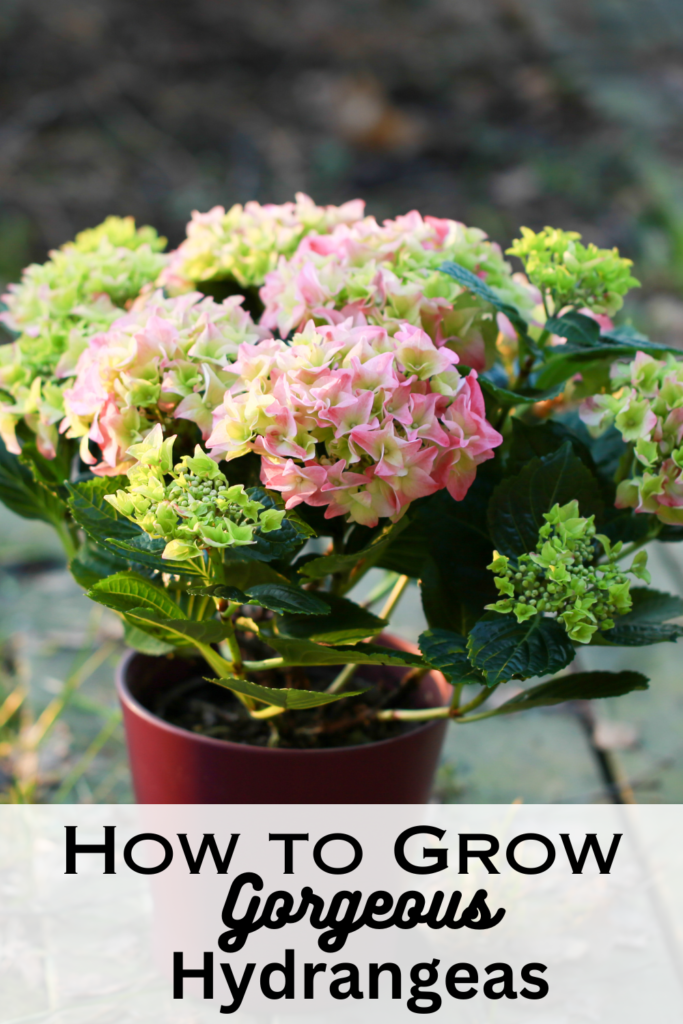
Common Hydrangea Challenges
Powdery mildew, spider mites, and leaf spots can sometimes trouble your hydrangeas.
To prevent problems, make sure your plants get good air circulation by spacing hydrangea plants properly to avoid overcrowding.
If problems persist, you can treat them with appropriate solutions available at your local garden center.
Blooms All Summer Long
When you learn how to grow hydrangeas the right way, they reward you with gorgeous blooms throughout the growing season!
From the early spring to the late fall, these showy flowers will brighten up your garden and bring a smile to your face. So learn how to grow hydrangeas and watch your yard transform into a colorful paradise!
More Gardening
If you know how to grow Hydrangeas and love it, Tag me on Instagram @farmhouse_harvest with your blooms!








